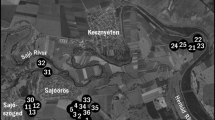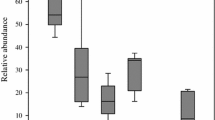Abstract
For the conservation of biodiversity, heathlands present important ecosystems throughout Europe. The formerly widespread habitats are nowadays restricted to small and isolated remnants. Without land use heathland vegetation undergoes succession and, in addition, the increasing amount of atmospheric nitrogen deposition has resulted in an encroachment of grasses. In the present study we analysed the effects of succession and grass encroachment on Orthoptera in a coastal heathland on the Baltic island of Hiddensee, Germany. Vegetation, microclimate, soil humidity and Orthoptera were sampled in the five main stages of heathland succession, namely grey dunes, dwarf-shrub heath, grassy heath, heath with shrubs, and birch forest. Vegetation and environmental parameters showed strong differences among the successional stages. Orthoptera species richness was highest in transitional stages. The high proportion of grasses offer favourable habitat conditions for graminivorous, chorto- and thamnobiont species. Orthoptera density was highest in grey dunes. Threatened and specialised species were restricted to the young stages grey dunes and dwarf-shrub heath. Hence, in order to maintain a high diversity of Orthoptera in heathlands, maintaining different successional stages is of critical importance and this should be integrated into heathland management practices.






Similar content being viewed by others
References
Arak A, Eiriksson T (1992) Choice of singing sites by male bushcrickets (Tettigonia viridissima) in relation to signal propagation. Behav Ecol Sociobiol 30:365–372
Báldi A, Kisbenedek T (1997) Orthopteran assemblages as indicators of grassland naturalness in Hungary. Agric Ecosyst Environ 66:121–129. doi:10.1016/S0167-8809(97)00068-6
Balmer O, Erhardt A (2000) Consequences of succession on extensively grazed grasslands for central European butterfly communities: rethinking conservation practices. Conserv Biol 14:746–757
Baur B, Cremene C, Groza G, Rakosy L, Schileyko AA, Baur A, Stoll P, Erhardt A (2006) Effects of abandonment of subalpine hay meadows on plant and invertebrate diversity in Transylania, Romania. Biol Conserv 132:261–273
Bellmann H (2006) Der Kosmos Heuschreckenführer. Die Arten Mitteleuropas sicher bestimmen, Kosmos, Stuttgart
Berdowski JJM (1993) The effects of external stress and disturbance factors on Calluna-dominated heathland vegetation. In: Aerts RH, Heil GW (eds) Heathlands: patterns and processes in a changing environment. Kluwer, Dordrecht, pp 85–124
Bieringer G, Zulka KP (2003) Shading out species richness: edge effect of a pine plantation on the Orthoptera (Tettigoniidae and Acrididae) assemblage of an adjacent dry grassland. Biodivers Conserv 12:1481–1495. doi:10.1023/A:1023633911828
Bonte D, Maes D (2008) Trampling affects the distribution of specialized coastal dune arthropods. Basic Appl Ecol 9:726–734
Bonte D, Criel P, Van Thournout I, Maelfait J-P (2003) Regional and local variation of spider assemblages (Araneae) from coastal grey dunes along the North Sea. J Biogeogr 30:901–911
Britton AJ, Pakeman RJ, Carey PD, Marrs RH (2001) Impacts of climate, management and nitrogen deposition on the dynamics of lowland heathland. J Veg Sci 12:797–806
Coray A, Lehmann AW (1998) Taxonomie der Heuschrecken Deutschlands (Orthoptera): Formale Aspekte der wissenschaftlichen Namen. Articulata, Beiheft 7:63–152
Cuesta D, Taboada A, Calvo L, Salgado JM (2008) Short- and medium-term effects of experimental nitrogen fertilization on arthropods associated with Calluna vulgaris heathlands in north-west Spain. Environ Pollut 152:394–402
Curry JP (1994) Grassland Invertebrates—Ecology, influence on soil fertility and effects on plant growth. Chapman and Hall, London
Detzel P (1998) Die Heuschrecken Baden-Württembergs. Ulmer, Stuttgart
Dobson AJ (2002) Introduction to generalized linear models, 2nd edn. Chapman and Hall, London
Fartmann T, Mattes M (1997) Heuschreckenfauna und Grünland—Bewirtschaftungsmaßnahmen und Biotopmanagement. Arbeiten aus dem Institut für Landschaftsökologie 3:179–188
Fielding AH, Haworth PF (1995) Testing the generality of bird-habitat models. Conserv Biol 9:1466–1481
Gardiner T, Hill J, Chesmore D (2005) Review of the methods frequently used to estimate the abundance of Orthoptera in grassland ecosystems. J Insect Conserv 9:151–173. doi:10.1007/s10841-005-2854-1
Gimingham CH (1972) Ecology of heathlands. Chapman Hall, London
Heil GW, Diemont WH (1983) Raised nutrient levels change heathland into grassland. Vegetatio 53:113–120
Ingrisch S, Köhler G (1998) Die Heuschrecken Mitteleuropas. Westarp-Wissenschaften, Magdeburg
Köhler G, Kopetz A (1993) Veränderungen in Heuschrecken (Saltatoria)-Assoziationen als Folgen der Verbuschung von Kalktrockenrasen. Arch Nat Lands 32:147–159
Kruess A, Tscharntke T (2002a) Contrasting responses of plant and insect diversity to variation in grazing intensity. Biol Conserv 106:293–302
Kruess A, Tscharntke T (2002b) Grazing intensity and the diversity of grasshoppers, butterflies, and trap-nesting bees and wasps. Conserv Biol 16:1570–1580
Lehmann AW, Haacks M (2006) Vorkommen von Conocephalus dorsalis (Latreille, [1804]) in vom Salzwasser beeinflussten Habitaten der schleswig-holsteinischen Nord- und Ostseeküste. Articulata 21:161–167
Lepš J, Šmilauer P (2003) Multivariate analysis of ecological data using CANOCO. Cambridge University press, New York
Leuschner C, Lendzion J (2009) Air humidity, soil moisture and soil chemistry as determinants of the herb layer composition in European beech forests. J Veg Sci 20:288–298
Leyer I, Wesche K (2007) Multivariate Statistik in der Ökologie. Springer, Berlin
Londo G (1976) Scale for relevés of permanent quadrats. Vegetatio 33:61–64
Londo G (1984) The decimal scale for relevés of permanent quadrats. In: Knapp R (ed) Sampling methods and taxon analysis in vegetation science. Handbook of vegetation science. Springer, The Hague, pp 45–49
Maes D, Bonte D (2006) Using distribution patterns of five threatened invertebrates in a highly fragmented dune landscape to develop a multispecies conservation approach. Biol Conserv 133:490–499
Maes D, Ghesquiere A, Logie M, Bonte D (2006) Habitat use and mobility of two threatened coastal dune insects: implications for conservation. J Insect Conserv 10:105–115
Marini L, Fontana P, Battisti A, Gaston KJ (2009) Response of orthopteran diversity to abandonment of semi-natural meadows. Agric Ecosyst Environ 132:232–236
Marrs RH (1993) An assessment of changes in Calluna heathlands in Breckland, Eastern England, between 1983 and 1991. Biol Conserv 65:133–139
Nagy A, Sólymos P, Rácz IA (2007) A test on the effectiveness and selectivity of three sampling methods frequently used in orthopterological field studies. Entomol Fennica 18:149–159
Niemeyer M, Niemeyer T, Fottner S, Härdtle W, Mohamed A (2007) Impact of sod-cutting and choppering on nutrients budgets of dry heathlands. Biol Conserv 134:344–353. doi:10.1016/j.biocon.2006.07.013
Öckinger E, Eriksson AK, Smith HG (2006) Effects of grassland abandonment, restoration and management on butterflies and vascular plants. Biol Conserv 133:291–300
Oksanen J, Kindt R, Legendre P, O’Hara B, Simpson GL, Solymos P, Stevens MH, Wagner H (2008) The vegan package version 1.15-0. Online at: http://cran.r-project.org/, http://vegan.r-forge.r-project.org/(27.04.2009)
Power SA, Barker CG, Allchin EA, Ashmore MR, Bell JNB (2001) Habitat Management: a tool to modify ecosystem impacts of nitrogen deposition. Sci World J 1:714–721. doi:10.1100/tsw.2001.379
Racz IA (1998) Biogeographical survey of the Orthoptera fauna in central part of the Carpathian Basin (Hungary): fauna types and communitiy types. Articulata 13:53–69
Reinhard H (1962) Klimatologie. Atlas der Bezirke Rostock, Schwerin und Neubrandenburg. VEB Topographischer Dienst, Schwerin
Remke E (2003) Vegetationsökologischer Vergleich von Heidegebieten der Insel Hiddensee, Mecklenburg-Vorpommern. Diploma thesis, University of Greifswald
Remke E, Brouwer E, Kooijman A, Blindow I, Esselink H, Roelofs JGM (2009a) Even low to medium nitrogen deposition impacts vegetation of dry, coastal dunes around the Baltic Sea. Environ Pollut 157:792–800
Remke E, Brouwer E, Kooijman A, Blindow I, Roelofs JGM (2009b) Low Atmospheric nitrogen loads lead to grass encroachment in coastal dunes, but only on acid soils. Ecosystems 12:1173–1188
Roem WJ, Klees H, Berendse F (2002) Effects of nutrient addition and acidification on plant species diversity and seed germination in heathland. J Appl Ecol 39:937–948
Rose RJ, Webb NR, Clarke RT, Traynor CH (2000) Changes on the heathlands in Dorset, England, between 1987 and 1996. Biol Conserv 93:117–125
Samways MJ (1997) Conservation biology of Orthoptera. In: Gangwere SK, Muralirangan MC, Muralirangan M (eds) The Bionomics of Grasshoppers. Katydids and their Kin. CAB International, Wallingford, pp 481–496
Schirmel J, Buchholz S, Fartmann T (2010a) Is pitfall trapping a valuable sampling method for grassland Orthoptera? J Insect Conserv 14:289–296. doi:10.1007/s10841-009-9258-6
Schirmel J, Blindow I, Fartmann T (2010b) The importance of habitat mosaics for Orthoptera (Caelifera and Ensifera) in dry heathlands. Eur J Entomol 107:129–132
Sjursen H, Michelsen A, Jonasson S (2005) Effects of long-term soil warming and fertilisation on microarthropod abundances in three sub-arctic ecosystems. Appl Soil Ecol 30:148–161
Skórka P, Settele J, Woyciechowski M (2007) Effects of management cessation on grassland butterflies in southern Poland. Agric Ecosyst Environ 121:319–324
Ssymank A, Hauke U, Rückriem C, Schröder E (1998) Das europäische Schutzgebietssystem NATURA 2000–BfNHandbuch zur Umsetzung der Fauna-Flora-Habitat-Richtlinie und der Vogelschutz-Richtlinie. Schriftenr Landschaftspfl Natursch 53:1–560
Strengbom J, Reich PB, Ritchie ME (2008) High plant species diversity indirectly mitigates CO2- and N-induced effects on grasshopper growth. Acta Oecologia 34:194–201
Sundermeier A (1998) Methoden zur Analyse der Vegetationsstruktur. In: Traxler A (ed) Handbuch des vegetationsökologischen Monitorings. Teil A: Methoden. Umweltbundesamt Wien:123–158
Venables WN, Ripley B (2008) The VR package version 7.2-45. Online at: http://www.stats.ox.ac.uk/pub/MASS4/(27.04.2009)
Webb NR (1998) The traditional management of European heathlands. J Appl Ecol 35:987–990
Whittaker JB (1988) Response of the heather psyllid, Strophingia ericae to addition of fertiliser to Calluna on heath and moorland. Bull Br Ecol Soc 16:102–104
Willot SJ, Hassall M (1998) Life-history responses of British grasshoppers (Orthoptera: Acrididae) to temperature change. Func Ecol 12:232–241
Wranik W, Meitzner V, Martschei T (2008) Verbreitungsatlas der Heuschrecken Mecklenburg-Vorpommerns. Beiträge zur floristischen und faunistischen Erforschung des Landes Mecklenburg-Vorpommern, LUNG M-V
Zehm A (1997) Untersuchungen zur Nahrungswahl von Heuschrecken (Orthoptera) in zwei Sand-Pioniergesellschaften der nördlichen Oberrheinebene. Articulata 12:131–140
Zuur AF, Ieno IN, Walker NJ, Saveliev AA, Smith GM (2009) Mixed effects models and extensions in ecology with R. Springer, Berlin
Acknowledgments
The study was funded by the Bauer-Hollmann Foundation (Stifterverband für die deutsche Wissenschaft) as part of the research project “Biodiversity, Ecology and Management of Coastal Habitats of the Baltic Sea”. The authors would like to thank S. Buchholz (Berlin), J. Schalajda (Winterthur) and two anonymous reviewers for helpful comments on an earlier version of the manuscript.
Author information
Authors and Affiliations
Corresponding author
Rights and permissions
About this article
Cite this article
Schirmel, J., Mantilla-Contreras, J., Blindow, I. et al. Impacts of succession and grass encroachment on heathland Orthoptera. J Insect Conserv 15, 633–642 (2011). https://doi.org/10.1007/s10841-010-9362-7
Received:
Accepted:
Published:
Issue Date:
DOI: https://doi.org/10.1007/s10841-010-9362-7




